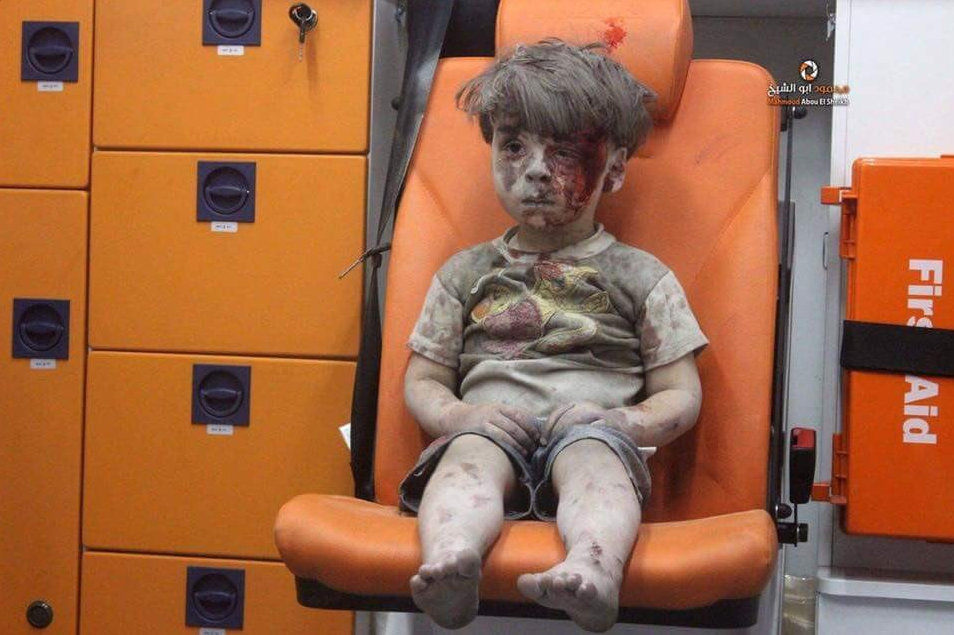Hitting the play button begins a scene that has played out in Syria thousands of times over the past five years. It’s dark and men are frantically yelling. A young child, later identified by media citing medical workers as five-year-old Omran Daqneesh, is passed between the arms of his rescuers from a building in Aleppo. He’s caked in dust. The left side of his face is smeared with blood.
He doesn’t make a sound.
The man on the ground, in a yellow vest, holds him tight as he walks away. The boy wraps his right arm around the man’s shoulder as he’s whisked into a waiting ambulance. He looks back outside as he’s placed on an orange seat, alone, next to orange cabinets and an orange first aid kit.
He doesn’t make a sound.
The man who carried him in bends down to get a walkie talkie and then leaves. Another man with a camera focuses on the boy. He’s wearing shorts and a t-shirt with a cartoon character. His hands are placed calmly on his thighs. His right eye is wide open, the other eye less so. He looks to the doors of the ambulance, toward the voices. He blinks and looks away.
In a moment of pure horror, the boy lifts his left hand to his face, runs his fingers through his hair and then back down the side of his face before dropping it down. He looks at the palm of his hand and, unsure what to do, turns it over and wipes it on the seat. In that moment, he was like every other kid, trying to get something off his hand.
He doesn’t make a sound.
That was just the first 37 seconds of footage shared on Aug. 17 by the Aleppo Media Center, reportedly showing the immediate aftermath of an apparent Syrian government or Russian airstrike in a rebel-held neighborhood of the northern city, which for years has been a battleground between government and opposition forces. The footage and a picture of the boy were shared widely online in the hours that followed.

The photographer was identified by the Associated Press as Mahmoud Raslan, who said Omran was rescued from the building with three siblings and their parents. He told the AP that none had sustained life-threatening injuries.
The picture instantly recalls that of Alan Kurdi, the Syrian-Kurdish toddler who was found dead on the Turkish shoreline almost a year ago. Kurdi, in a red t-shirt and blue shorts, was face down. The world soon learned that he had died with his older brother and mother after their boat capsized overnight on the way to Greece. That picture went viral online during the historic influx of migrants and refugees into Europe, highlighting the thousands who perished trying to flee something bad for something better.
The images of Alan and Omran do have similarities: a young boy in a vulnerable position, alone. They each instantly became the face of their own tragedy, a response of sorts to the major global players who could push to end the madness: Kurdi, as a dead refugee, and Omran, as one of the thousands of Syrian children caught in an endless war.
They are both powerful. Here, the video is crucial. The viewer is instantly put in that ambulance with Omran, watching as he tries to decipher what has happened to his body. Every subtle expression, every gesture.
His silence instantly resonates with those who watch the footage. His daze is enough to reduce a viewer to tears. The realizations begin to set in that he should be crying. That he should be surrounded by someone he knows. That he is a survivor, saved by brave first-responders. That he should be anywhere else than in the back of an ambulance by himself.
The video comes just days after more than a dozen doctors who remain in the rebel-held side of Aleppo wrote a letter to President Obama, asking for aid for the civilians who are trapped. “We do not need tears or sympathy or even prayers,” the letter reads. “We need your action.”
After focusing on the boy, the footage then shows a girl wearing pink who had been placed in the ambulance. Another boy is carried in to join them. Later, a bloodied man in a white tank top is helped from the building, with blood all over his face. He is lead into the ambulance before the doors close. In the video’s final moments, a body is removed from the rubble on an orange stretcher as men shout Allahu Akhbar. It’s not clear whether that person was dead or alive.
Devastating pictures and footage from Syria are common now. Bloodied children are pulled out from underneath a sea of rubble. Men and women are hurried from the scene. Ambulances arrive empty and leave full. Bodies pile up. The next day brings the same thing.
A simple search on Twitter could reveal a dozen scenes like this before lunch. They largely come from cameras held by activists and citizen journalists. This is the new normal.
But Omran is unique. It’s that he is alive. It’s that he is, to a point, aware. It’s his face. It cannot be unseen.
More Must-Reads From TIME
- The 100 Most Influential People of 2024
- Coco Gauff Is Playing for Herself Now
- Scenes From Pro-Palestinian Encampments Across U.S. Universities
- 6 Compliments That Land Every Time
- If You're Dating Right Now , You're Brave: Column
- The AI That Could Heal a Divided Internet
- Fallout Is a Brilliant Model for the Future of Video Game Adaptations
- Want Weekly Recs on What to Watch, Read, and More? Sign Up for Worth Your Time
Contact us at letters@time.com